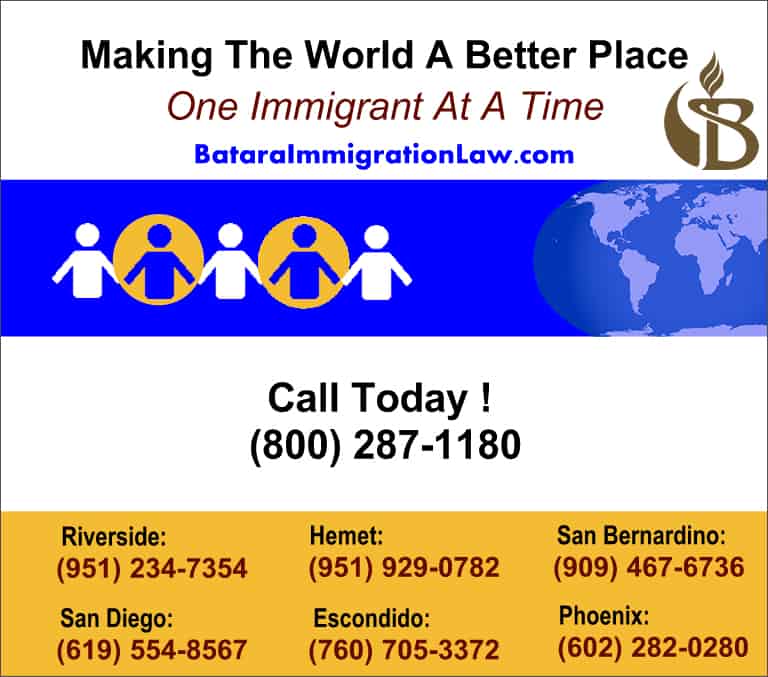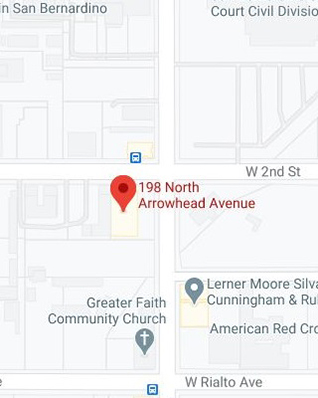Marriage Is A Big Step . . .
Especially When You Live In Different Countries
Love Across Borders: We Can Help Bring Your Fiancé To The United States
Often, our clients are citizens who want to immigrate and bring the person they love to live with them in the United States. A fiancé visa is frequently their best solution.
For example:
- Maybe you’re a U.S. citizen engaged to your future wife whom you met during your vacation in another country.
- Perhaps while you were working overseas, you feel in love with and already betrothed yourself to the woman of your dreams.
- Or your bride-to-be has children from a previous marriage and you want to raise them as part of your family unit.

What Is A Fiancé Visa?
A fiancé visa, also known as a K-1 visa, is a visa issued to a foreign-born fiancé to enter the United States for 90 days for the purpose of marrying a U.S. citizen. If the marriage does not occur within that time period, the immigrant fiancé must leave the country.
The rules for K-1 visas apply equally to fiancés and fiancées. For the sake of simplicity, we primarily use fiancé on this page.
Both fiancé and fiancée are French words. The two words confuse many English speakers.
- Fiancé (with one “e”) is a man who is engaged to be married.
- Fiancée (with two “e’s”) is a woman who is engaged to be married.
Thus, the K-1 rules discussed here apply equally to both males and females engaged to be married.
What Are The Requirements
For Fiancé K-1 Visas?
As noted earlier, a fiancé visa allows U.S. citizens to bring their future spouses, who live in another country, into the United States in order for the couple to get married. Here is a brief summary of how you qualify for a fiancé visa.
- You Must Be A U.S. Citizen
- You And Your Fiancé Must Intend To Get Married Within 90 Days
- You Must Have Met With Your Fiancé Within The Past Two Years
- You And Your Fiancé Must Be Lawfully Eligible To Marry
- You Must Meet The Minimum Income Requirements
- Your Fiancé Must Not Fall Into Any Of The Inadmissibility Categories
1. You Must Be A U.S. Citizen
Whether you were born in the U.S. or obtained your citizenship through the naturalization, derivation, or acquisition process, you are eligible to immigrant your future spouse through the fiancé visa process.
If you are only a permanent resident, you do not qualify to use the fiancé visa process.
2. You And Your Fiance Must Intend To Get Married Within 90 Days
Once your fiancé enters the U.S., you and your fiancé have 90 days to marry and apply for permanent residency.
This means, to qualify for the K-1 visa, you need to show you have made some marriage plans. Since you do not know exactly when the visa will be approved, some of the details will not be specific.
However, letters from companies which cater weddings, print shops which produce wedding invitations, and halls which host wedding receptions can help prove your seriousness.
Notarized letters from you and your fiancé regarding your engagement are also helpful.
3. You Must Have Met With Your Fiance Within The Past Two Years
Nowadays, many couples meet over the internet. If this is the case, you need to arrange to meet with your loved one prior to filing immigration documents.
Again, the government requires firm evidence of this meeting. Items which are useful to show such a meeting actually took place include:
- Hotel and lodging receipts
- Airplane tickets, receipts, and departure/landing schedules
- Copies of your passport with stamps showing entries and exits
- Credit card statements showing payments
- Photos taken together during your visit
- Restaurant, transportation, parking tickets, and similar items
In some limited situations, you may be excused from this requirement. For example, in some cultures, a husband and wife cannot meet before their marriage date. Or perhaps a medical or physical condition prevents you from traveling abroad.
4. You And Your Fiancé Must Be Lawfully Eligible To Marry
Here are the most common stumbling blocks which might hinder you from living happily ever after with the love of your life in the United States:
- You or your fiance is under 18 years old.
- You or your fiance has been previously married
- You and your fiance are related by blood
5. You Must Meet The Minimum Income Requirements
You must agree to be your fiance’s financial sponsor. If you do not meet the government’s income requirements, you can ask a relative or friend to serve as your fiancé’s financial co-sponsor.
6. Your Fiancé Must Not Fall Into Any Of The Inadmissibility Categories
The inadmissibility list includes certain diseases, criminal convictions, memberships in certain organizations, past history of immigration fraud, living unlawfully in the U.S., and drug trafficking.
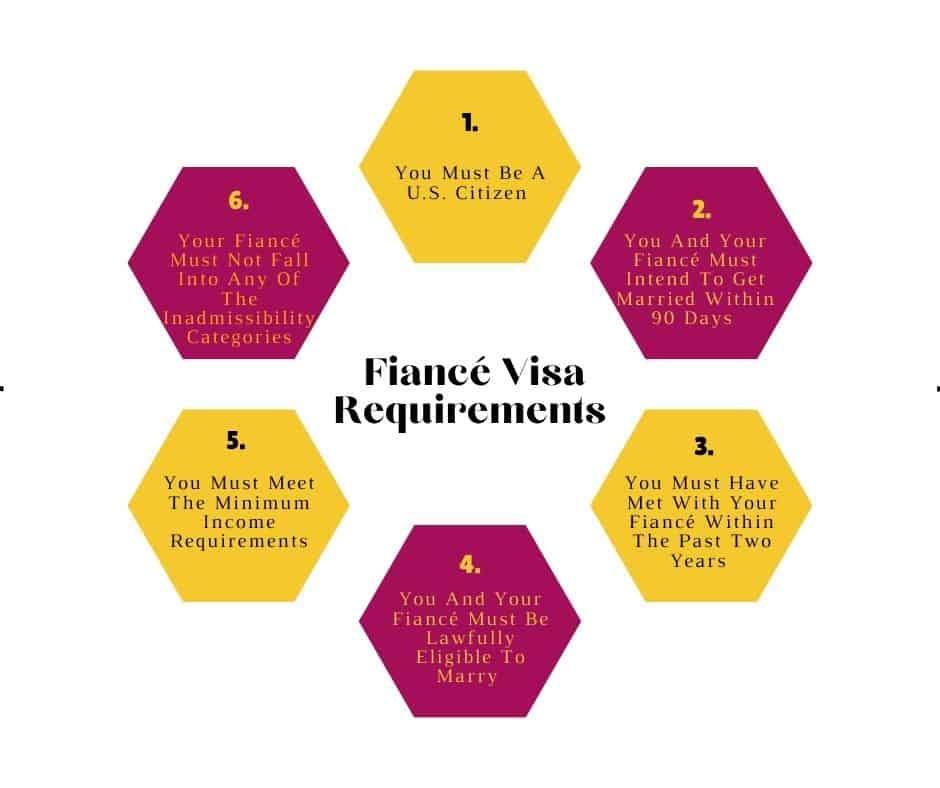
K-2 Visas: Minor Children Of Your Fiancé
If your fiance has children born in another country, even if they are not your biological children, they may be able to join your fiancé on a K-2 visa.
The children must be under the age of 21 and unmarried.
To qualify, they must go through the same process as your fiancé. In addition, you must be able to financially sponsor them, as well as your fiancé.
Navigating The Fiance Visa Process: What You Must Know For A Successful Outcome
How Does The K-1 Visa Process Work?
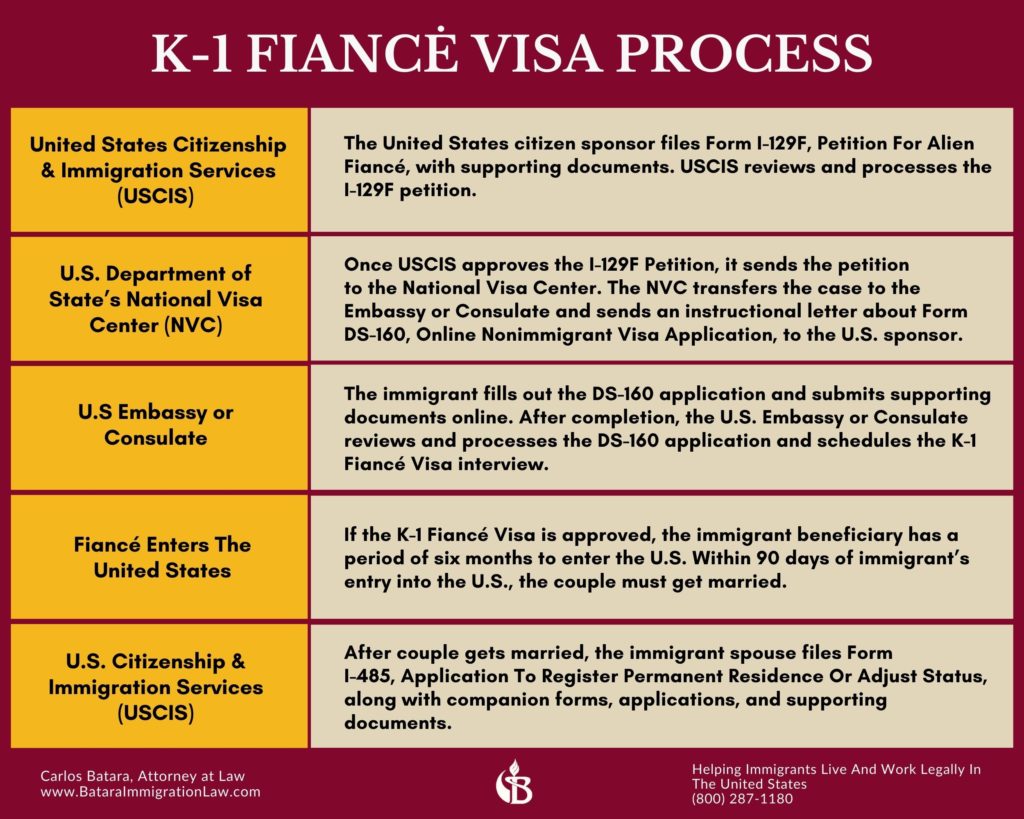
As the chart above shows, the fiance visa process has five distinct steps from start to finish.
- The United States citizen sponsor files Form I-129F, Petition For Alien Fiancé, with supporting documents. USCIS reviews and processes the I-129F petition.
- Once USCIS approves the I-129F Petition, it sends the petition to the National Visa Center. The NVC transfers the case to the Embassy or Consulate and sends an instructional letter about Form DS-160, Online Nonimmigrant Visa Application, to the U.S. sponsor.
- The immigrant fills out the DS-160 application and submits supporting documents online. After completion, the U.S. Embassy or Consulate reviews and processes the DS-160 application and schedules the K-1 Fiancé Visa interview.
- If the K-1 Fiancé Visa is approved, the immigrant beneficiary has a period of six months to enter the U.S. Within 90 days of immigrant’s entry into the U.S., the couple must get married.
- After the couple gets married, the immigrant spouse files Form I-485, Application To Register Permanent Residence Or Adjust Status, along with companion forms, applications, and supporting documents
K-1 Fiancé Visa Videos
See our Fiance Visas here:
Your Bridge To Success: Nationwide And Worldwide Fiancé Visa Services
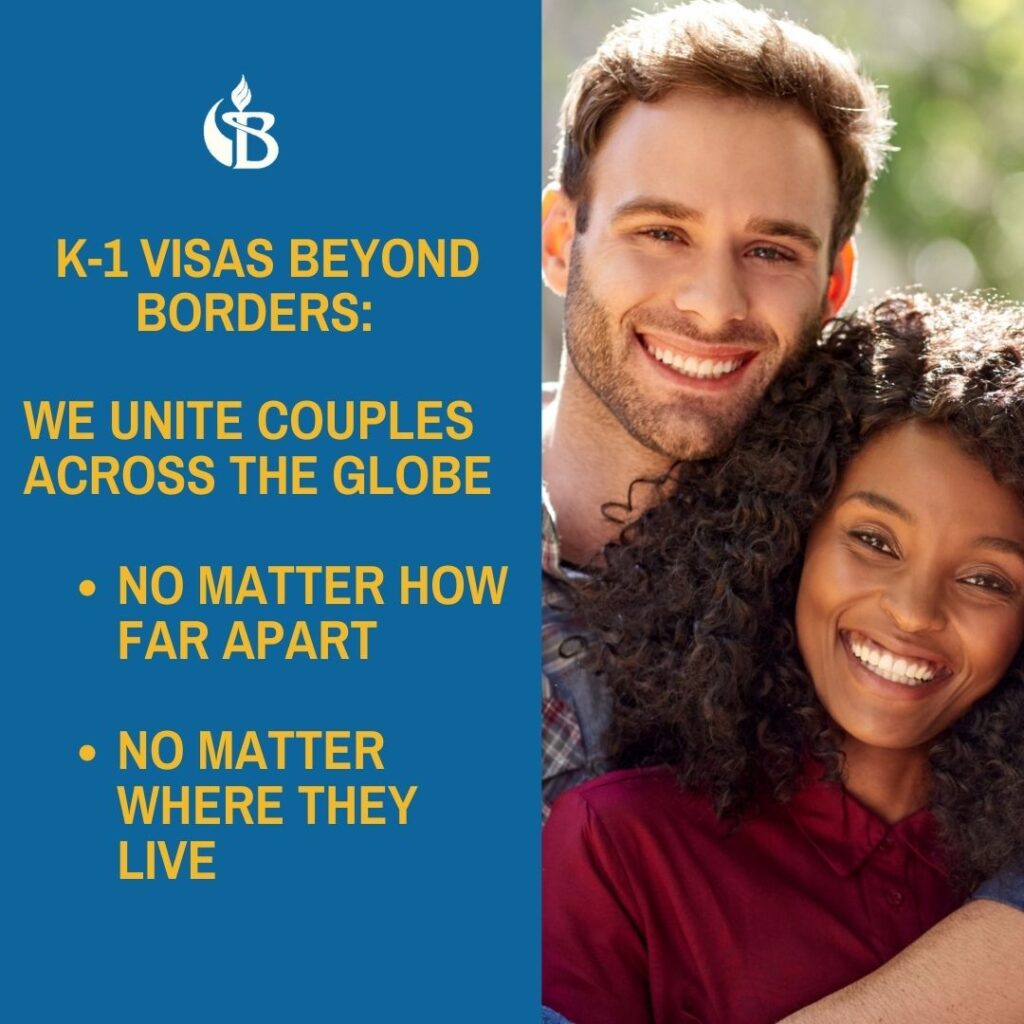
We offer a hybrid of traditional and modern legal services for clients worldwide.
We have physical offices to meet face-to-face in various cities throughout Southern California for clients who would like to work with us in a traditional manner.
Even though these brick-and-mortar offices are located in the Inland Empire – covering all of San Bernardino and Riverside Counties – our services for K-1 visas help clients on a national and global basis.
Over two decades ago, long before COVID-19 increased awareness about working with clients long distance, we developed innovative immigration virtual law services to assist fiancés, spouses, and other family members living abroad.
By using traditional communications like e-mail, telephone, U.S. mail and fax — as well as advanced technology such as video-conferencing and online client files – we are able to assist you and your family wherever you live, with the same ease as if you lived next door.
In short, this approach allows our immigration offices to help your family, even if divided by state and national boundaries, in an efficient and cost-cutting manner.
So why wait any longer?
Bringing Hearts And Lives Together:
Local Offices, Global Solutions
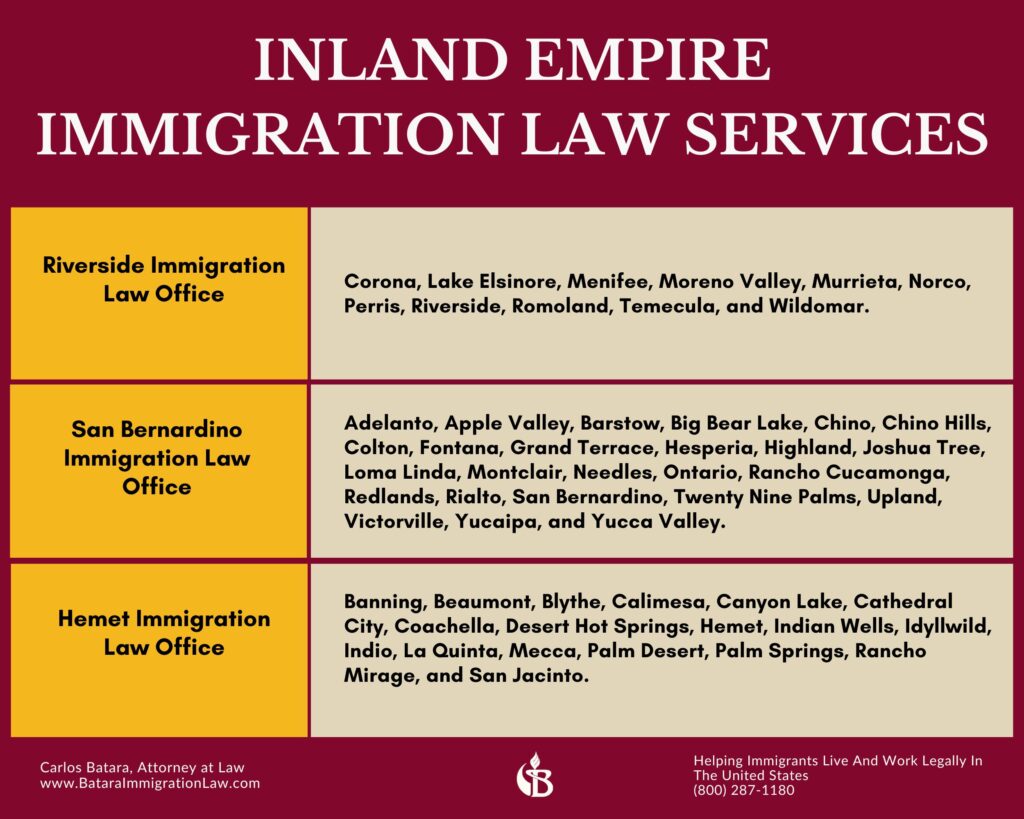
For more than 25 years, as a Fiancé Visa attorney and K-1 lawyer, Carlos Batara has brought together immigrants from 125+ different countries.
We provide a full range of K-1 visa services for boyfriends and girlfriends throughout the entire Inland Empire through our online and virtual law offices.
Riverside K-1 Fiancé Visa Services
Our Riverside and Hemet immigration law offices assist K-1 visa applicants who live in or nearby Corona, Lake Elsinore, Menifee, Moreno Valley, Murrieta, Norco, Perris, Riverside, Romoland, Temecula, and Wildomar.
San Bernardino Fiancé Visa K-1 Services
At the San Bernardino office, we guide K-1 visa applicants living in or close to Adelanto, Apple Valley, Barstow, Big Bear Lake, Chino, Chino Hills, Colton, Fontana, Grand Terrace, Hesperia, Highland, Joshua Tree, Loma Linda, Montclair, Needles, Ontario, Rancho Cucamonga, Redlands, Rialto, San Bernardino, Twenty Nine Palms, Upland, Victorville, Yucaipa, and Yucca Valley.
Hemet K-1 Fiancé Visa Services
The K-1 visa clients served by our Hemet immigration law office typically reside in or nearby Banning, Beaumont, Blythe, Calimesa, Canyon Lake, Cathedral City, Coachella, Desert Hot Springs, Hemet, Indian Wells, Idyllwild, Indio, La Quinta, Mecca, Palm Desert, Palm Springs, Rancho Mirage, and San Jacinto.
If you’re thinking about bringing your fiancé to the United States, and you’re serious about discovering how to win a K-1 visa . . .
Let’s schedule your Strategy And Planning Session today.
